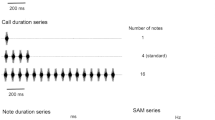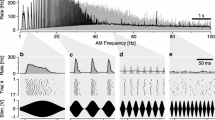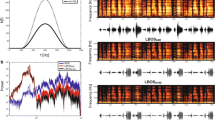Abstract
-
1.
Characteristics of single units in the trout torus semicircularis to acousticolateral stimulation were investigated with tone bursts.
-
2.
Auditory (A) units (33%,N=67), exclusively sensitive to frequencies higher than 125 Hz, and low frequency (L, 12%) units responding to tones up to 125 Hz were found next to the third type, the broadband (B, 55%) unit, sensitive to both low and high frequencies. For many B units sensitivity to intermediate frequencies is absent.
-
3.
The sensitivity range of 85% of the units does not exceed 450 Hz.
-
4.
Most units (70%) show an increase in spike firing during the tone burst irrespective of frequency (ON units), but for a minority (9%) firing is maximal in the silent intervals (OFF units). OFF units are mostly found among A units. All L units are ON units. The remaining ON/OFF (ON behaviour for some and OFF behaviour for other frequencies) or ON+OFF (ON and OFF behaviour for all frequencies) units are all B units. Tonic ON units are most common.
-
5.
Some units show habituation and only sensitive ones may exhibit phase-locking.
-
6.
The different behaviour of some B units for low versus high frequencies, as expressed in their ON and OFF behaviour and latencies, presumably reflects convergence of inputs from acousticolateral subsystems with distinct properties.
Similar content being viewed by others
References
Abbott RR (1973) Acoustic sensitivity in salmonids. Ph D Thesis, University of Washington, DC
Enger PS (1963) Single unit activity in the peripheral auditory system of a teleost fish. Acta Physiol Scand 59: (Suppl 210): 1–48
Fay RR (1981) Coding of acoustic information in the eighth nerve. In: Tavolga WN, Popper AN, Fay RR (eds) Hearing and sound communication in fishes. Springer, Berlin Heidelberg New York, p 189
Fine ML (1981) Mismatch between sound production and hearing in the oyster toadfish. In: Tavolga WN, Popper AN, Fay RR (eds) Hearing and sound communication in fishes. Springer, Berlin Heidelberg New York, p 257
Hawkins AD (1981) The hearing abilities of fish. In: Tavolga WN, Popper AN, Fay RR (eds) Hearing and sound communication in fishes. Springer, Berlin Heidelberg New York, p 109
Hawkins AD, Johnstone ADF (1978) The hearing of the atlantic salmonSalmo salar. J Fish Biol 13:655–673
Horner K, Sand O, Enger PS (1980) Binaural interaction in the cod. J Exp Biol 85:323–331
Horner K, Hawkins AD, Fraser PJ (1981) Frequency characteristics of primary auditory neurons from the ear of the codGadus morhua L. In: Tavolga WN, Popper AN, Fay RR (eds) Hearing and sound communication in fishes. Springer, Berlin Heidelberg New York, p 223
Johnson DH (1974) The response of single auditory-nerve fibers in the cat to single tones: synchrony and average discharge rate. Ph D Thesis, Cambridge, Massachusetts Institute of Technology
Knudsen EI (1977) Distinct auditory and lateral line nuclei in the midbrain of catfishes. J Comp Neurol 173:417–432
Kuiper JW (1967) Frequency characteristics and functional significance of the lateral line organ. In: Cahn P (ed) Lateral line detectors. Indiana University Press, Indinapolis, p 105
Münz H, Claas B, Fritzsch (1984) Electroreceptive and mechanoreceptive units in the lateral line of the axolotlAmbystoma mexicnum. J Comp Physiol A 154:33–44
Page CH (1970) Electrophysiological study of auditory responses in the goldfish brain. J Neurophysiol 33:116–128
Page CH, Sutterlin AM (1970) Visual-auditory response in the goldfish tegmentum. J Neurophysiol 33:129–136
Piddington RW (1971) Central control of auditory input in the goldfish. II. Evidence of action in the free-swimming animal. J Exp Biol 55:585–610
Schellart NAM (1983) Acousticolateral and visual processing and their interaction in the torus semicircularis of the trout,Salmo gairdneri. Neurosci Lett 42:39–44
Schellart NAM, Zweijpfenning RCVJ, Nederstigt LJA (1984) Convergence of auditory and lateral line processing in the torus semicircularis of the trout (Salmo gairdneri). Society for Neuroscience Abstracts, vol 10, p 1151
Smit HW, Schellart NAM, Grimbergen CA (1986) A gain controlled frequency sweep generator for auditory stimulation. Med Biol Eng and Comp (in press)
Strelioff D, Sokolich WG (1981) Stimulation of lateral line sensory cells. In: Tavolga WN, Popper AN, Fay RR (eds) Hearing and sound communication in fishes. Springer, Berlin Heidelberg New York, p 481
de Wolf FA, Schellart NAM, Hoogland PV (1983) Octavolateral projections to the torus semicircularis in the trout,Salmo gairdneri. Neurosci Lett 38:209–213
Author information
Authors and Affiliations
Rights and permissions
About this article
Cite this article
Nederstigt, L.J.A., Schellart, N.A.M. Acousticolateral processing in the torus semicircularis of the troutSalmo gairdneri . Pflugers Arch. 406, 151–157 (1986). https://doi.org/10.1007/BF00586676
Received:
Accepted:
Issue Date:
DOI: https://doi.org/10.1007/BF00586676




